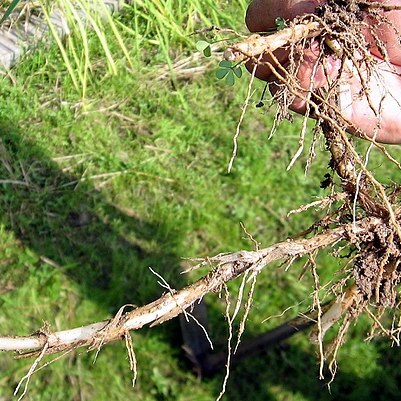Fertile lemma slightly shorter than the spikelet, cymbiform, semi-elliptic-oblong, coriaceous; flanks finely tessellate, stiffly hispid to a varying degree; keels usually stiffly ciliate towards the apex; lateral apical protrusions mostly distinct; awn (2·6)4-7·5 cm. long, rather slender, straight or slightly wavy, usually pink when fresh (at least in the upper part) or often purplish, scabrous with short stiff forward directed bristles.
Perennial hydrophyte to 1200 m high; rhizome extensive, branched; culms spongy. Leaf blade to 450 x 15 mm, long auricled; ligule 15-45 mm long, acute, often split along middle. Spikelet 7-9 mm long, obliquely attached to pedicel; glumes 1/4 the spikelet length; lemma awn 20-80 mm long, scabrid; anther 5.5-6.5 mm long; stigma long.
Panicle 16-40 x 2·5-8 cm., narrowly oblong to narrowly elliptic in outline, erect or slightly drooping, dense, many-flowered; rhachis obtusely angular, usually smooth, glabrous; branches obliquely ascending to nearly erect, somewhat stiff, angular, scaberulous, glabrous but usually with a tuft of short hairs at the very base.
Leaf-laminae 10-75 x 0·5-2·5 cm., linear, linear-lanceolate to very narrowly elliptic, broadest below the middle, acuminate, bright to dark green, somewhat flaccid, asperulous on the upper, smooth or somewhat asperulous on the lower surface, usually scabrous along the margins, glabrous, midrib often indistinct.
A cereal grass that keeps growing from year to year. It has extensive underground stems or rhizomes. It forms tussocks. The stalks grow 1.3 m high and are 1 cm across. They are soft and spongy and form roots from the nodes. The leaf blade is 45 cm long and 15 mm wide.
Sterile lemmas nearly equal in shape and size, (2)2·5-3·8(-4·5) mm. long, lanceolate to broadly lanceolate, acute to acuminate, sometimes 3-dentate with the central tooth dominating the lateral (see fig. D.1), glabrous, smooth.
Perennial, hydrophyte and rhizomatous (rhizomes extensive, branched), up to 1.2 m high (culms spongy). Leaf blades up to 450 mm long, up to 15 mm wide; ligule 15-45 mm long, acute. Spikelets 7-9 mm long (awns 40-80 mm long).
Culms up to 250 cm. tall or more, up to 2·5 cm. or more in diam., (2)4-10-noded, erect or ascending, sometimes floating, weak, spongy, the submerged parts whitish, developing aerial roots from the nodes, glabrous, smooth.
Leaf-sheaths scarious, spongy, usually tessellate, pale-green to brownish, shorter or nearly as long as the internodes, with up to 15 mm. long narrow auricles at the mouth, glabrous, smooth.
Spikelets 7-12(-15) mm. long (excl. awn) and 2-3 mm. wide, deciduous, obliquely attached to the pedicel, asymmetrically elliptic-oblong in lateral view, pale-green to brownish.
Palea slightly shorter than the lemma and much narrower but of the same consistency and indument; apex acute or tapering into a subacute point, somewhat outwardly curved.
Caryopsis 7·5-8·5 mm. long, oblong in lateral view, glabrous, light-brown, glossy.
Pedicels 0·5-4(-7) mm. long, stout, angular, scabrous or smooth.
Ligule (0·8)1·5-5·5 cm. long, narrowly triangular, acute.
A robust perennial with long creeping branched rhizomes.
Stamens 6; anthers 4·5-5·5 mm. long, linear-oblong.
Glumes reduced to a narrow membranous rim.
Stigmas blackish.


